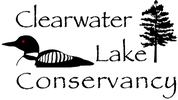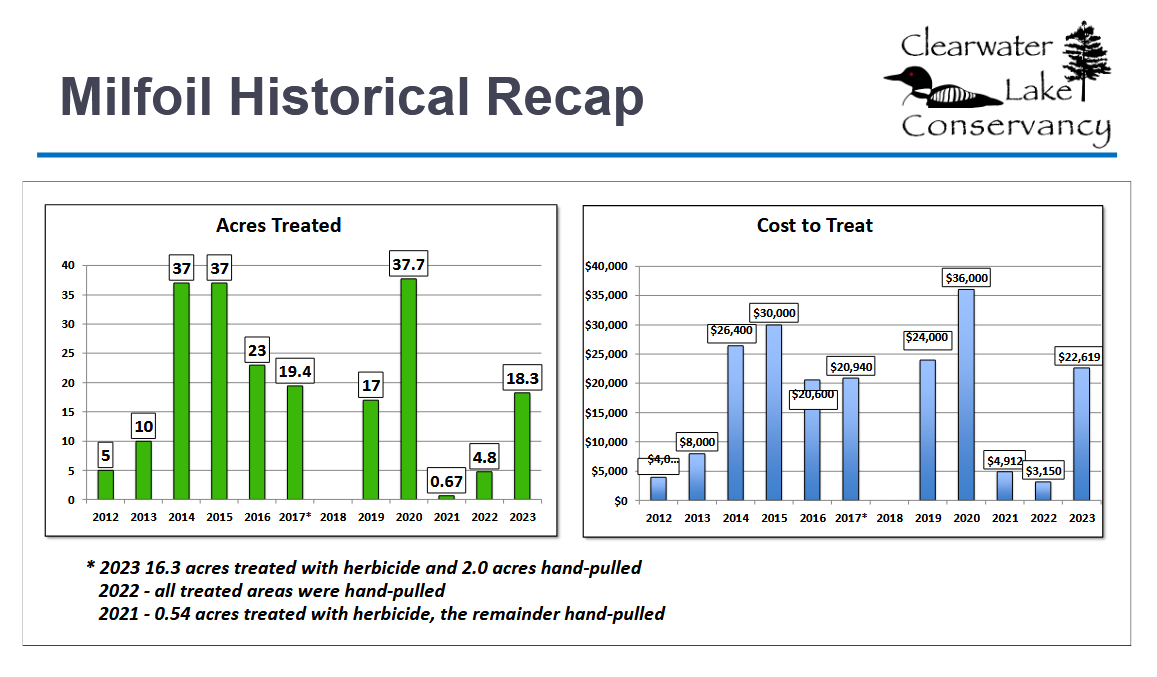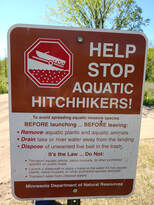Treatment History
There are 2 ways to attack Eurasian Milfoil; with chemicals and hand pulling.
When treatment for Clearwater Lake was first started in 2011, the amount of milfoil present was too large to consider hand pulling it all. In 2011 and 2012 several individual home owners treated their own areas. However, it became clear that a whole lake approach was necessary.
In 2013 Clearwater Lake Association Board (Now Clearwater Lake Conservancy) took over treatment of Eurasian Milfoil. The Board evaluated the the options, talked with the DNR and discussed treatment approaches and success rates with other lakes in the area fighting Eurasian Milfoil. The Board recommended a containment approach through chemical treatment using a professional to the Lake Association.
When treatment for Clearwater Lake was first started in 2011, the amount of milfoil present was too large to consider hand pulling it all. In 2011 and 2012 several individual home owners treated their own areas. However, it became clear that a whole lake approach was necessary.
In 2013 Clearwater Lake Association Board (Now Clearwater Lake Conservancy) took over treatment of Eurasian Milfoil. The Board evaluated the the options, talked with the DNR and discussed treatment approaches and success rates with other lakes in the area fighting Eurasian Milfoil. The Board recommended a containment approach through chemical treatment using a professional to the Lake Association.
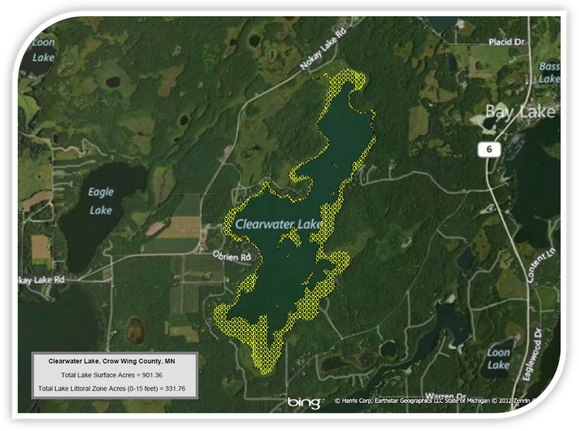
A DNR permit is required every year that defines the area to be treated.
The DNR may limit the treatment request based upon the a lake's littoral zone, the areas of infection, and the time of year of treatment.
The littoral zone is the near shore area where sunlight penetrates all the way to the sediment and allows aquatic plants (macrophytes) to grow.
Clearwater Lake's littoral zone is in yellow.
The DNR may limit the treatment request based upon the a lake's littoral zone, the areas of infection, and the time of year of treatment.
The littoral zone is the near shore area where sunlight penetrates all the way to the sediment and allows aquatic plants (macrophytes) to grow.
Clearwater Lake's littoral zone is in yellow.
Clearwater Lake the treatment area is restricted to a maximum treatment area of 37 acres. They have also restricted treatment in areas does not affect owner use. For example, along the shore of Clearwater Forest Camp that are not actively used. Depending on the treatment, areas of rushes or lilly pads must be treated in the fall, after the native species of died off for the year.
MN DNR must approve the chemical being used for chemical treatment.
Original chemical treatment was a DNR approved 2-4-D based product. In 2019, a test area was designated using a highly recommended DNR approved product called ProcellaCORp. The test results were very impressive and in 2020 we treated all 37 acres with ProcellaCORp. The following year, 2021 the results were stunning. We treated only .67 acres with chemicals and hired a professional dive team to hand pull the remaining acres. 2022 we hand pulled all identified areas.
|
The MN DNR approves ProcellaCORp. The MN DRN has evaluated ProcellaCORp after a 3 year study that includes it's affect on native aquatic plants. This quote is found on page 37.
Find the full report on our DNR / Other Resources web page or the MN DNR website.
For more information about the approval process - see this letter from the MN DNR invasive specialist Tim Plude.
|
Extract from 2021 MN DNR
DNR staff worked with local and industry partners
to evaluate the aquatic herbicide ProcellaCOR® for the management of Eurasian watermilfoil and its hybrids. In 2021 DNR published the results of three years of work done in Lake Jane in Washington County with ProcellaCOR® (florpyrauxifen‑benzyl). The treatments successfully reduced hybrid Eurasian watermilfoil coverage in target areas with little to no observed effects on native aquatic plants. Reductions to hybrid watermilfoil persisted through at least the year following treatment. |
The Board remains vigilant in monitoring the lake, working with a consultant and keeping the Lake Associations Members aware of the status and treatment plans each year.
Maps of Infection
Funding
The lake association asked for member donations and has pursued state, county and DNR grants to support our treatment plan. There has also been a large donor, our Friends of the Lake that has been very generous.
Eurasian Milfoil Management Summary
Treatments Signatures
|
Chemical treatment requires the consent of the lake shore homeowner. The DNR no longer requires an annual signature authorization for chemical treating. An implied consent is understood if guidelines are followed.
Tim Plude, Brainerd, DNR has confirmed we can notify owners by email, newsletter, flyers etc. of pending chemical treatment. Those that do not want chemical treatment should inform us of their preference for non-treatment. This is process we have followed for the last few years. According to the DNR, permission is not required for hand-pulling and chemical treatment greater than 150 feet from shore. |
If you want to let us know you will allow or deny
chemical treatment please contact. |
2023 MILFOIL IS BACK
Eurasian MilFoil
Boating around the lake, you can see this is a horrible Eurasian Milfoil year. It appeared to explode everywhere. Our lake is not unique, many lakes have experienced a bad year for this invasive.
The Clearwater Lake Conservancy ordered an early survey and a fall survey - you can see the maps on the Invasive Maps.
Based upon the first survey, The Dive Guys were hired for an 8 hour day to clear the patches in heavy traffic areas. On July 12 five to six bobcat loads of milfoil were removed from 3 - 5 patches. This cleared the higher risk areas but left the majority of the lake untreated.
The Clearwater Lake Conservancy voted to do a chemical treatment with Procellacor on 11.33 acres This will treat areas approved for mid-summer treatment by the DNR. The remaining areas will be treated in the fall when the native plants such as bullrush and lily pads have died off. The summer treatment was done on 8/24/2023.
The Clearwater Lake Conservancy ordered an early survey and a fall survey - you can see the maps on the Invasive Maps.
Based upon the first survey, The Dive Guys were hired for an 8 hour day to clear the patches in heavy traffic areas. On July 12 five to six bobcat loads of milfoil were removed from 3 - 5 patches. This cleared the higher risk areas but left the majority of the lake untreated.
The Clearwater Lake Conservancy voted to do a chemical treatment with Procellacor on 11.33 acres This will treat areas approved for mid-summer treatment by the DNR. The remaining areas will be treated in the fall when the native plants such as bullrush and lily pads have died off. The summer treatment was done on 8/24/2023.
A 2nd survey was performed on 9/8/2023. Based upon this survey, the board requested a permit to treat an additional 10.95 acres with Procellacor once the natives have gone dormant in the fall.
Chemical treatment requires landowner approval within 150 feet of shore. As in previous years, the DNR is allowing us to use the "opt out" method, which mean approval is assumed with notification. Land owners are required to notify the Clearwater Lake Conservancy if they do not want herbicide treatment. To do this please contact Charlie Lick as soon as possible. The first wave of chemical treatment is roughly the week of 8/21.
Patches of milfoil in front of property whose owner has "opted out" of chemical treatment may be hand pulled.
See the formal chemical notice here.
Monitoring The Boat Landing
Clearwater Conservancy Board approved additional Boat Landing Monitoring for 2023. We added Friday coverage and additional hours over Memorial Day Weekend. This coverage added 144 hours of coverage over the summer.
2022 Great Milfoil Report
Eurasian MilFoil
Our Eurasian Milfoil survey showed very little Milfoil in our lake this year. Thirty-nine (39) sites were identified in the survey. Twenty-six (26) sites / 4.8 areas was recommended eligible for chemical treatment. The rest were all recommended as hand pulling. Due to the limited infestation, the board decided to use Hand Pulling as a treatment for all 39 sites. No Chemical treatments were done in 2022.
You can see the maps on the Invasive Maps page and the full report on the Lake Reports page.
You can see the maps on the Invasive Maps page and the full report on the Lake Reports page.
Curly Leaf Pondweed
Curly Leaf Pondweed did come back this Spring. Due to it's limited area and that it arrives early and fades early, the Board decided not to treat this invasive this year. We will continue to monitor the patch and review treatment next year.
Zebra Mussels and Spiny Water Flees
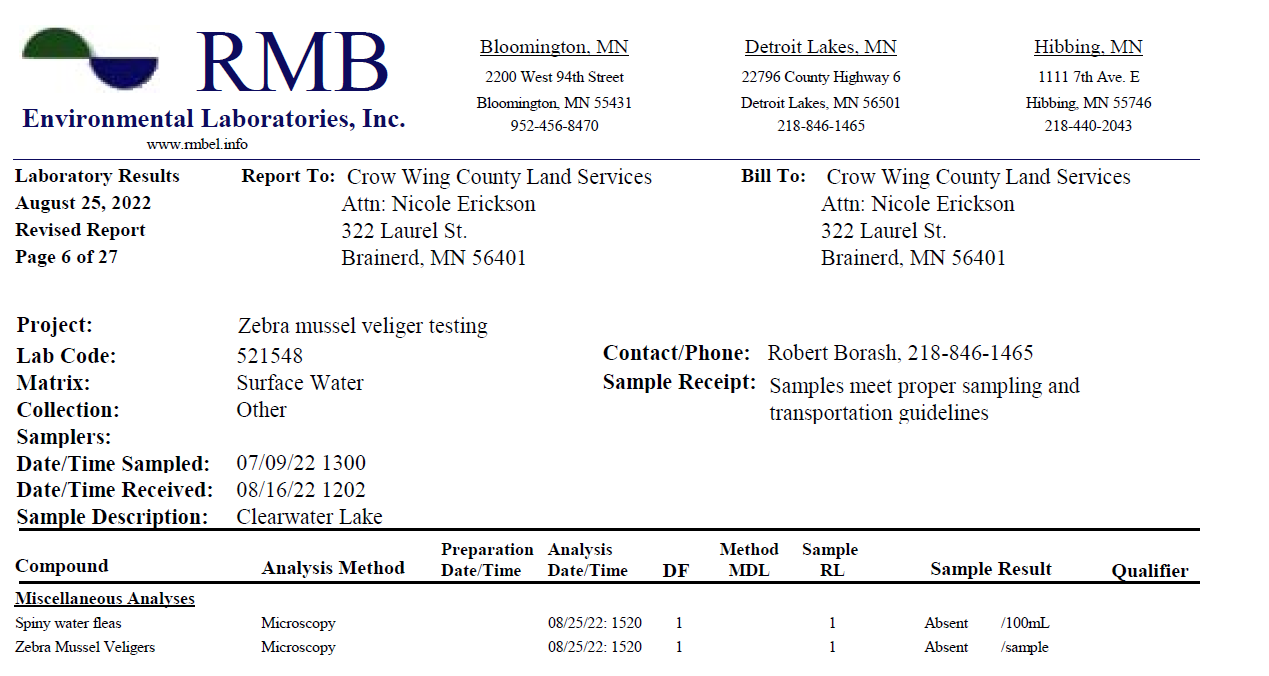
Once again we came back as "Absent" for Zebra Mussels and Spiny Water Fleas. See the full report on the Lake Reports page. Clearwater lakes report card is on page 6.
Monitoring The Boat Landing.
Use our on-line donation option
- 2021:
- Plant Survey was completed by RMB Environmental Laboratories in July of 2021. The survey showed no significant plant life loss between 2018 and 2021.
- Milfoil survey was performed in September GREAT SUCCESS! The 36.4 acres treated in 2020 were almost completely eliminated.
- Only .67 acres of Eurasian Milfoil were recommended for chemical treatment. With other patches recommended for hand pulling.
- A large patch of Curly Leaf Pondweed was found in the NW corner of the most SW bay of Clearwater Lake.
- Plant Survey was completed by RMB Environmental Laboratories in July of 2021. The survey showed no significant plant life loss between 2018 and 2021.
- 2020:
- Infestation was back up to 2015 levels with the worst progressing areas are in the SE shore of the lake.
- The trial areas treated with Procellacor area in the SW corner (NW corner of the south most bay) improved dramatically.
- Due to the success of trial area and other outside positive feedback; permits were requested and granted by the MN DNR for the recommended 37.5 acres of Eurasian Water Milfoil with Procellacor. 36.4 acres were treated after permissions were reviewed.
- The cost was roughly $34,000 and was paid by state and county grants and Clearwater Lake Conservancy Environmental Funds provided by donations from our members.
- Results were very impressive.
- 2019:
- The DNR inspected our lake for the appropriate permits and approved 17 acres.
- Switched product to 2-4-D GRANULAR for a more direct application. Results were very poor. Could be our milfoil has become resistant to this treatment, or that the application failed for some reason.
- Several undeveloped areas were left untreated as a control group to monitor.
- Permission to treat in front of a property was required.
- Notified Lake Members with Treatment Plan Newsletter. Read the Newsletter.
- Did a test area with a new highly recommended product Procellacor. - Results were very good.
- Did water testing after treatment to determine concentrations of chemicals. See Water Testing Results.
- Hired a Limnologist to review the treatment and water testing. See his report Analysis of 2,4-D Treatment
|
|
| ||||||||||||||||||
- 2018: No Treatment was done to allow the Board to do research on lake members concerns.
- 2017: Central Minnesota Aquatics has done an initial lake survey that shows great success; Letter from Central Minnesota Aquatics. It is early in the year and another survey will be performed with the spring treatment. It is estimated there will be 14 acres treated at a cost of roughly $15,000.
- 2016: We did both a spring and fall treatment covering 23 acres. The total cost was $20,600. The state grants have been removed from the state budget.
- 2015: A spring treatment of 37 acres was done in June, 2015. State and county grants of $8,700 helped cover the treatment cost of $30,000. The spring treatment was so successful, that the fall treatment was canceled.
- 2014: A fall treatment of 37 acres was done in 2014. State and county grants of $8,700 helped cover the treatment cost of $26,400.
- 2013: One fall treatment of 10 acres was done in 2013. A state grant of $1,500 received to help cover the treatment cost $8,000. The treated area showed 70% reduction in milfoil. Unfortunately, the treatment process revealed that we have many more acres of infection then previously thought.
- 2011 & 2012: Homeowner treatments. Minimal success.
